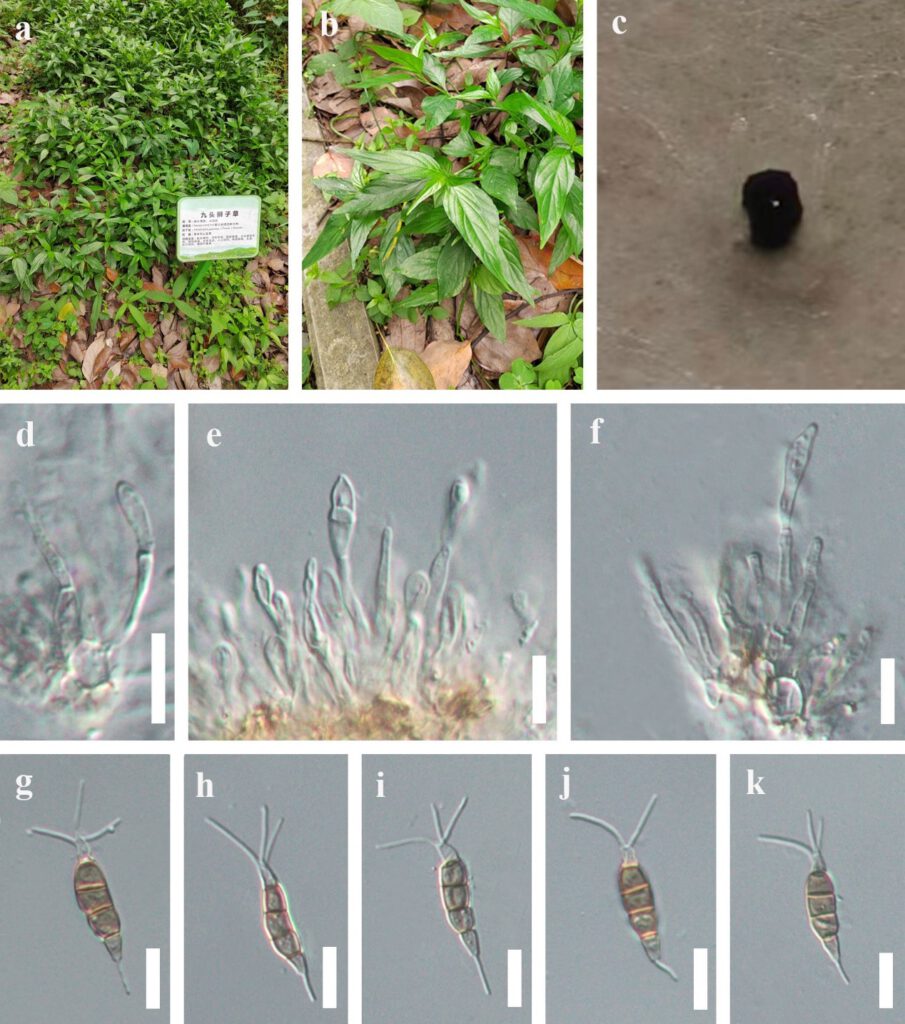Pestalotiopsis chamaeropis Maharachch., K.D. Hyde & Crous, Studies in Mycology. 79: 158 (2014) Fig.17
Index Fungorum number: IF 809735; MycoBank number: MB 809735; Facesoffungi number: FoF 11691;
Endophytic from Peristrophe japonica. Colonies on PDA white with grey mycelia in the center, felty, black conidiomata, lobed edge. Sexual morph: Not observed. Asexual morph: Conidiomata on PDA pycnidial, solitary or aggregated, subglobose to globose, dark, semi-immersed or erumpent; exuding black conidial masses. Conidiophores hyaline, smooth, simple, reduced to conidiogenous cells. Conidiogenous cells 1.2–2.0 μm wide, cylindrical to sub-cylindrical, hyaline, smooth. Conidia brown, fusiform, straight to slightly curved, 4-septate, 20.0–27.5 × 3.7–5.8 μm, ± SD = 24.5 ± 1.3 × 5.0 ± 0.4 μm (n = 40), L/W ratio = 4.9; basal cell obconic with a truncate base, hyaline to pale brown, smooth walled, 3.2–6.0 μm long ( ± SD = 4.8 ± 0.5 μm); three median cells 12.5–17.5 μm long ( ± SD = 14.5 ± 0.9 μm), brown, septa darker than the rest of the cell, somewhat constricted at the septa; second cell from base brown, 4.0–5.8 μm long ( ± SD = 5.0 ± 0.4 μm); third cell brown, 3.5–6.0 μm long ( ± SD = 4.7 ± 0.4 μm); fourth cell brown, 4.0–5.8 μm long ( ± SD = 4.7 ± 0.4 μm); apical cell 3.0–5.4 μm long ( ± SD = 4.1 ± 0.5 μm), hyaline, conic to acute; with 2–3 tubular appendages on apical cell, inserted at different loci in a crest at the apex of the apical cell, unbranched, 8.5–18.0 μm long ( ± SD =13.8 ± 2.1 μm); single basal appendage, unbranched, tubular, centric, 4.0–9.7 μm long ( ± SD = 5.6 ± 0.7 μm).
Material examined – China, Guizhou Province, Guiyang City, Nanming District, Guiyang Medicinal Botanical Garden, on healthy leaves of Peristrophe japonica (Thunb.) Bremek. (Acanthaceae), 1 May 2022, Y.R. Sun, E33 (HUGP 803, dried culture; living culture GUCC 800).
Notes – Pestalotiopsis chamaeropis was originally reported on leaves of Chamaerops humilis in Italy by Maharachchikumbura et al. (2014). Subsequently, many studies have proven that P. chamaeropis is a serious phytopathogen, which can cause diseases of Camellia sinensis, Camellia oleifera and Eurya nitida (in China), Erica arborea (in Tunisia), Japanese andromeda (in Japan) and Prostanthera rotundifolia (in Australia) (Moslemi and Taylor 2015, Jiang et al. 2017, Ariyawansa and Hyde 2018, Hlaiem et al. 2018, Nozawa et al. 2019, Wang et al. 2019, Chen et al. 2021, Qiu et al. 2022, Santos et al. 2022). Park et al. (2017) reported P. chamaeropis as an endophyte, from the leaves of woody plants in Korea. In this study, our strain GUCC 800 is phylogenetically clustered with P. chamaeropis CBS 186.71 with maximum support (ML-BS = 100%, BYPP = 1), and it has overlapping characteristics with P. chamaeropis (CBS 186.71). Thus, we identify GUCC 800 as P. chamaeropis, representing a new host record.

Figure 17 – Pestalotiopsis chamaeropis (HUGP 803, new record). a, b Host. c Close up view of conidiomata, d–f Conidia attached to conidiogenous cells, g–k Conidia. Scale bars: d–k = 10 µm.
